Features (articles)
Looking at tofu

(Periodically I like to dust off an article from the vast Just Hungry archives, give it a little facelift, and present it on the front page again. I wrote this guide to tofu back in September 2008. I think it will answer most, if not all, your questions about Japanese-style tofu and related products. Enjoy!
There are several tofu recipes both here in Just Hungry as well as on Just Bento, and I've even shown you how to make your own tofu from scratch. However, up until now I have never really tried to explain the differences between types of tofu, when to use them and how to store them. Well now is the time to fix that.
Fried tofu type 1: Aburaage

Aburaage (油揚げ)is deep fried tofu, where almost none of the soft white tofu remains. It's also called tofu skin or tofu pocket sometimes. When the tofu is deep fried, an air pocket is formed inside which can be stuffed, as in inarizushi or eggs in treasure bags. Besides stuffing it, you can use aburaage sliced up and put into soups or stir-fries, gently cooked whole in a broth as in kitsune udon, and more.
To get rid of the excess oil on the surface, blanch aburaage in boiling water for a couple of minutes, then drain away. To loosen it up so that it's easier to stuff, roll a round chopstick over the surface several times after blanching to loosen it up, then cut open.
The best way to store aburaage for longer than a few days is to freeze it. (The bag in the photo is actualy frozen.)
Japanese aburaage is always a rectangular sheet, but you can get small puffs or squares in Chinese markets.
Note: Don't confuse aburaage with canned (or packaged) inarizushi (or 'bean bag' sushi) skins, which have been cooked in a sweet-salty sauce. That is just one way to prepare aburaage. The canned inarizushi skins do tend to be rather high in salt, sugar and MSG, though they are very convenient to use. See how to make inarizushi from scratch, using plain aburaage.
Fried tofu type 2: Atsuage or namaage

Atsuage (厚揚げ)or namaage (生揚げ)is a block of tofu that has been slowly fried in oil until it forms a slightly crinkly pale brown skin. It's stil white tofu inside though, unlike aburaage. You can get rid of the excess oil on the surface just like with aburaage, by blanching it in boiling water. Aburaage is a very versatile food, that can be pan-fried or grilled like a steak, cut up and used in stir-fries or stewed, put into soups and so on. I like using aburaage in bento recipes a lot - because it has less moisture than non-fried tofu, it keeps longer.
The two main types of plain tofu
Finally we get to plain tofu. Plain tofu can be divided into two main types: silken or kinugoshi (絹ごし), and firm or pressed. In Japanese firm tofu is called momen (木綿)or cotton tofu. Here are a block of each: silken on the left, and firm/cotton on the right.
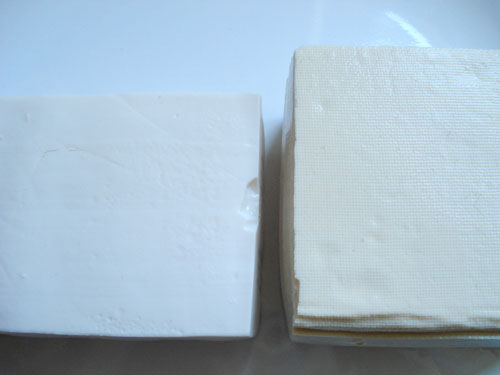
Here are the blocks from the side:
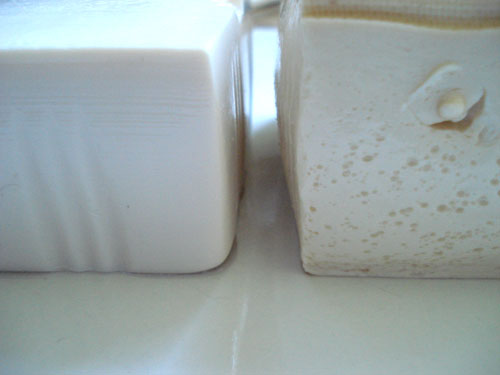
As you can see, the silken tofu is smoother and more watery, while the firm/cotton tofu is well, firmer and denser. Since silken tofu is much softer (higher water content), it is harder to handle if you want the tofu pieces to not fall apart. So if you are a tofu beginner and you want to use it on stir-fries or things like bacon wrapped tofu, you will want to use firm tofu. Firm tofu is less liable to fall apart, especially if you drain off the water a bit. Some recipes call for extracting even more water from the tofu (see using tofu for bento friendly recipes). On the other hand, silken tofu is more suited for recipes that call for it to be pureed, such as quick tofu pudding and baked squash and apple pudding, or in smoothies. I prefer silken tofu in miso soup, though firm is fine too.
Some other tofu types not pictured here
I don't have these on hand so pictures are missing...
Yaki dofu (焼き豆腐)is firm tofu that's been grilled on the outside, giving it a nice flavor.
Kouya dofu (高野豆腐)is freeze-dried tofu that is sold in the dried food section. It looks like little dried beige sponges. This is reconstituted in water before stewing. It can be a good pantry staple because it keeps indefinitely. Update: All about kouya dofu
Yuba (湯葉) is a Kyoto speciality. Thin films of tofu are scooped off the top of vats of warm soy milk. It's available in dried form and is usually used in soups and such. Fresh yuba made from fresh warm soy milk is considered a great delicacy and is usually eaten with a litle soy sauce, yuzu juice and such.
How to keep tofu fresh
Once you open the vacuum sealed pack the tofu comes in, any leftovers must be stored in an airtight container in the refrigerator, immersed in water. You will need to change the water every day too, but in any case don't keep opened tofu for more than 2 or 3 days. (With homemade tofu the shelf life is even shorter - a maximum of 2 days.) If you leave tofu out of water for more than a day in the fridge, it will take on a sour taste, not to mention picking up stray refrigerator smells! It is possible to freeze tofu (see frozen tofu cutlets) but the texture will change.
As mentioned above, aburaage can be frozen. Firm atsuage can also be frozen, though the inner texture will change a bit.
Calories in tofu products
Per 100 grams or about 3.5 oz:
- Aburaage: 386 calories (one piece is about 20-25g) This is the calorie count before getting rid of the surface oil, so after it's cooked it would be a bit lower in calories.
- Atsuage: 150 calories - (one piece is anywhere from 100 to 200g, depending on the brand etc.) This is the calorie count before getting rid of surface oil.
- Silken tofu: 56 calories
- Firm/cotton tofu: 72 calories
- Yaki dofu: same as firm tofu
- Kouya dofu (dry weight): 590 calories
- Kouya dofu (cooked weight): 130 calories
- Yuba (cooked weight): 150 calories
What about those stories I hear about soy being good for you/bad for you?
Whenever I write about soy or tofu products here, I usually get some comments or emails about how soy products are either bad for you (the current trend - makes men grow breasts and so on) or good for you (prevents certain types of cancer and what have you).
My attitude about these types of reports is this: Tofu has been eaten for hundreds or thousands of years. Generally speaking soy products are a great source of vegetable based protein and fat. And in any case, no one should be eating massive quantities of any one food product every day of the week, as seems to be the case with those reports of body builders taking lots of soy protein powder and sprouting boobies and such. Even the most die hard tofu fan in Japan, like my mother, does not eat tofu every single day. (For what it's worth, she has IBD and finds tofu to be one of the few easily digestible proteins.) Variety is the spice of life, and your diet! See also: A problematic report on the dangers of soy.
Hopefully most if not all of your tofu related questions have been answered here. If not, ask away in the comments!
See also
- How to make your own ganmodoki - a kind of tofu fritter that's available in packaged form, but is much better when freshly made
- Tofu from bean to plate - a small family-run company in Kyoto that makes tofu and also runs a wonderful tofu-kaiseiki restaurant. Includes pictures of special types of tofu and soy milk - tofu at its best!

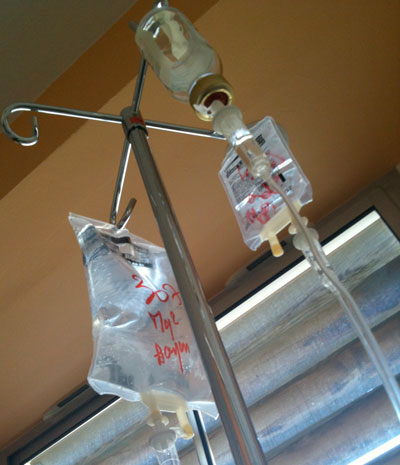

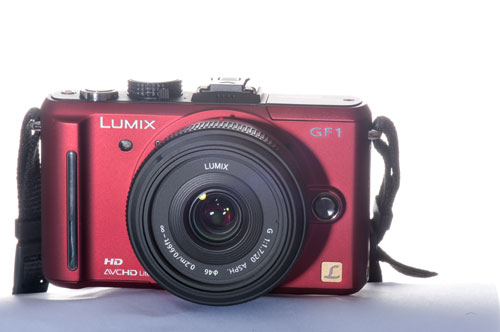
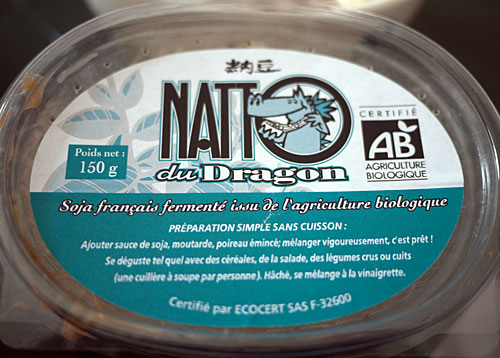
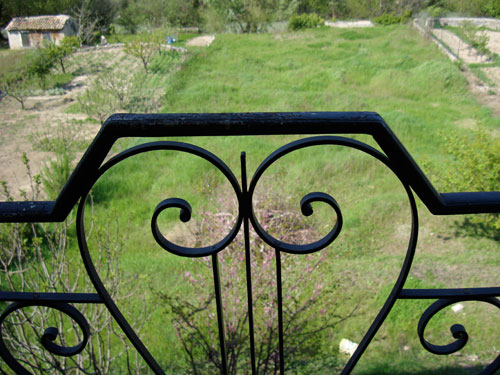
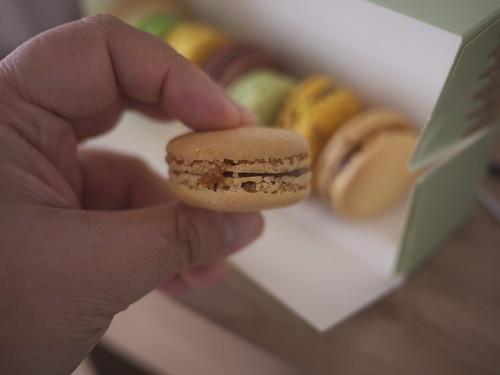

 Welcome to Just Hungry, where we serve authentic Japanese recipes and more! I'm
Welcome to Just Hungry, where we serve authentic Japanese recipes and more! I'm 













